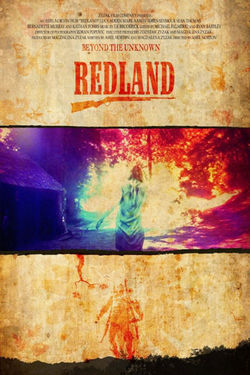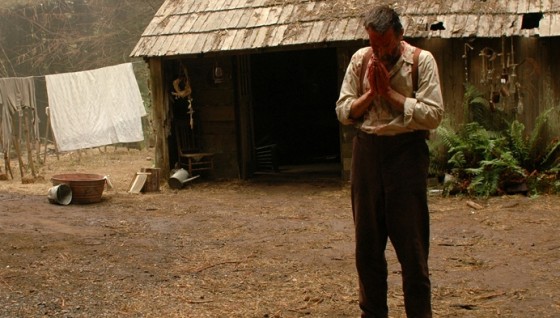
The positive spin on Redland – the uncompromising new arthouse drama from first-time director Asiel Norton – would be to call it contemplative. The negative spin would be to call it boring. Regardless of how the film hits you it is undeniable that Redland is slow as fuck. Sadly, I think I easily could have been sucked into the contemplative camp, were it not for Norton’s contrived stylistic choices, which made the film feel more pretentious than its story deserved, and worse, made it a chore for me to watch.
The film opens with a gut-wrenching blow. Literally. Mary-Ann (Lucy Adden), a wispy childlike teenage blond, alone in a field, gives herself an abortion caveman style – by repeatedly punching herself in the stomach with increasing violence. The most disturbing aspect of the scene is that it takes a moment for you to figure out what the hell you’re witnessing. It is a jarring and intense way to begin a film, and it signals that despite the near nap-inducing section of the film that follows, there will be more disquieting moments to come.
Redland is set during the Great Depression (though the film never actually says so; I only confirmed this by checking with the press material), and focuses on a family scraping to eek out an existence in the deep forest of an unspecified area of America. As far as portraits of young females in a hardscrabble community, Mary-Ann’s life makes Winter’s Bone seem like Keeping Up With the Kardashians. This family – comprised of Father, Ma, older brother Job, and younger brother Paul – has it rough. Already desperate for food, tragedy strikes when the family’s store of rabbits escape. Father decides there needs to be an elk hunt, for hides and food, so he summons a “neighbor’s” son, Charlie (Toben Seymour). But Father also suspects that Charlie was the one who impregnated Mary-Ann, so tensions run high on the lengthy hunt. Dangerously so.
This is a “heart of darkness” kind of tale, where our characters descend down a dark path either of their own actions or the tragic confluence of events. While the trailer for Redland wisely focuses on the thriller aspect of the men’s elk hunt (which is rarely thrilling in actuality), the most captivating/devastating portions of the film happen with Mary-Ann, Ma, and younger brother Paul back home while the older men are away. As the three are slowly starving, Mary-Ann picks a bunch of mushrooms for the three to feast on. Alas, the mushrooms turn out to be of the hallucinogenic kind, and the three really pigged out on them too. What sounds like a plot point from an American Pie sequel is played deadly serious in Redland, and contains some of the film’s most haunting imagery. I gotta hand it to Norton for making a scene in which a cute blond dry humps of log neither sexy nor comical. But he does. It is plain unpleasant.

The performances are all uniformly naturalistic and solid, with a special nod to Mark Aaron as the joyless, hard-nosed Father. And though I’ve already described almost everything that happens in the film, I liked the story and this window into a world rarely captured in cinema. But man o’ man is this film slow. All things considered, like any red-blooded American, I would prefer that a film err on the side of being too fast-paced, versus too slow-paced. This isn’t to say I dislike slow-paced films. I think the number of buddies and ex-girlfriends I’ve lulled to sleep by forcing them to watch Fantasia or The Dark Crystal would beg to differ. It is the contemplative stride of films like Assassination of Jesse James that makes them so electrifying.
Despite the almost agonizing pace, I think Redland could have worked for me. Yes, it’s a slow burn, but it builds and builds, and resolves in the most unpleasant happy ending I’ve seen in a while. But Norton’s execution of the film just didn’t work for me. This is the kind of film that includes a lot of static bumper footage of the locale. 5% of the film’s runtime is made up of macro-lens shots of insects. Another 5% of shots of trees. Another 10% of the various characters just sitting/standing there thinking or doing something tangential. This isn’t what rubbed me the wrong way. In fact, some of these shots – particularly of the immense vegetation of the forest – are quite beautifully photographed. But Norton and Director of Photography Zoran Popovic made the choice to execute the film with three alternating styles of visuals: 1) regular unadorned shots, 2) extreme tight focused close-ups, and 3) blurry selective focus shots that almost bring to mind the silent-film-era mimicry of Guy Maddin, minus the whimsy.
If Redland had been shot in a straight-forward fashion, I might have even loved it. Impossible to say. But the focal gimmickry kept pulling me out of the film, and at its worst reminded me of watching student films, as it felt more like an artistic experiment than something that was supposed to enhance the narrative; like a grad student obsessed with Terrence Malick still at that phase in his development where he is poorly aping his idols. Here is obviously where subjectivity comes into play. For those who dig a good artistic expression experiment, you may dig Redland. You may dig it a lot. For me it felt a bit too pretentious.
I know a guy who hates it when people refer to film (or art in general) as “pretentious.” He feels that calling art pretentious is itself pretentious, because it seems to demand that artists should be penalized for affecting importance in their work. While it’s fun to listen to him wax on the subject, I disagree. Pretension is like comedy. It’s all subjective. If nothing is pretentious than nothing isn’t funny. It’s a boring “everything is terrible, thus nothing is terrible” philosophy that destroys the fun of creative discussions and critiques. Norton crafted a simple, effective, and powerful story about family ties, jealousy, and the will to survive. There is nothing pretentious about the ideas or elements presented in the narrative, but the intentionally conspicuous visual styling of the film (when combined with its snail’s pace) makes Redland feel like every art-film-phobe’s worst nightmare.
Rating: 




Out of a Possible 5 Stars